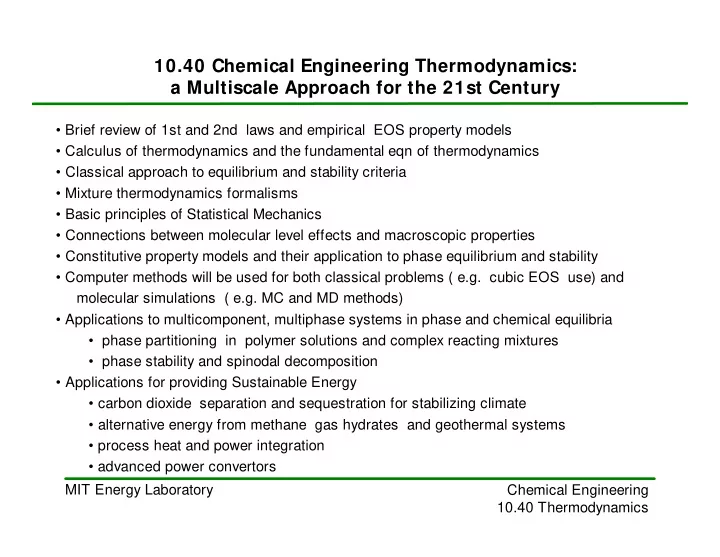

10.40 Chemical Engineering Thermodynamics: a Multiscale Approach for the 21st Century • Brief review of 1st and 2nd laws and empirical EOS property models • Calculus of thermodynamics and the fundamental eqn of thermodynamics • Classical approach to equilibrium and stability criteria • Mixture thermodynamics formalisms • Basic principles of Statistical Mechanics • Connections between molecular level effects and macroscopic properties • Constitutive property models and their application to phase equilibrium and stability • Computer methods will be used for both classical problems ( e.g. cubic EOS use) and molecular simulations ( e.g. MC and MD methods) • Applications to multicomponent, multiphase systems in phase and chemical equilibria • phase partitioning in polymer solutions and complex reacting mixtures • phase stability and spinodal decomposition • Applications for providing Sustainable Energy • carbon dioxide separation and sequestration for stabilizing climate • alternative energy from methane gas hydrates and geothermal systems • process heat and power integration • advanced power convertors MIT Energy Laboratory Chemical Engineering 10.40 Thermodynamics
10.40 Chemical Engineering Thermodynamics: Fall 2000 4-0-8 MTWTh • Instructors -- Professors J. Tester and B. Trout • Teaching Assistants -- Matthew Reagan and Michael Timko • Completely revised content merging elements of the old 10.40 and 10.42 • Incorporates both classical and molecular concepts • Emphasis on applying fundamentals to problem solving • Meets formally for 4 class periods per week 9 to 10 am MTWTh MIT Energy Laboratory Chemical Engineering 10.40 Thermodynamics
10.40 Chemical Engineering Thermodynamics: Your first assignment for Wed 9/ 6/ 00 • read chapters 1-3 of our text , Thermodynamics and Its Applications, 3rd ed • optional - you might find it helpful to revisit your undergraduate thermodynamics and physical chemistry textbooks, for example, • Smith and Van Ness, 5th ed. Chapters 1-5, 8-10 • Kyle, 2nd ed (1992) Chapters 1-4, 5.1-5.5, 8, 9, and 15 • Sandler, 2nd ed Chapters 1-4, parts of 6 and 7 • Castellan, Physical Chemistry • Alberty and Silbey, Physical Chemistry • Atikins, Physical Chemistry • look over the problems at the end of Chapter 3 in our text, for example problems 3.9 and 3.10 MIT Energy Laboratory Chemical Engineering 10.40 Thermodynamics
Old Versions of 10.40 And 10.42 pre-21st Century Transport Reaction Eng. CORE Thermodynamics 10.42 (Spring) 10.40 (Fall) Advanced Thermodynamics Chem. Eng. Thermodynamics • Emphasis on modeling properties in non- • Focus on applying fundamentals to solve ideal systems problems • Molecular to macroscopic scales • Brief review of 1st & 2nd Laws • General treatment of classical statistical • Calculus of thermodynamics via Gibbs mechanics fundamental equation • Virial EOS & corresponding states • Equilibrium and stability criteria • VdW & McMillan-Mayer theory • Constituitive property models • Lattice & Flory-Huggins models -PVTN EOS (empirical) • Local composition models -Connection to molecular effects • Quasi-chemical models -Activity coefficient models • Electrolytes • Applications • Phase stability and critical phenomena -Mixtures • Spinodal decomposition -Phase and chemical equilibria • Electromagnetic and potential fields -Pinch and availability analysis • Surface thermodynamics
Transport Reaction Eng. CORE Thermodynamics NEW 10.40 Focus on applying fundamentals to solve problems • Brief review of 1st & 2nd Laws • Calculus of thermodynamics via Gibbs fundamental equation • Equilibrium and stability criteria • Constituitive property models -PVTN EOS (empirical) -Connection to molecular effects -Activity coefficient models • Applications -Mixtures -Phase and chemical equilibria -Pinch and availability analysis •Emphasis on modeling properties in non-ideal systems • Molecular to macroscopic scales • General treatment of classical statistical mechanics • Virial EOS & corresponding states • VdW & McMillan-Mayer theory • Lattice & Flory-Huggins models • Local composition and quasi-chemical models • Phase stability and critical phenomena • Spinodal decomposition
10.40 Chemical Engineering Thermodynamics: a Multiscale Approach for the 21st Century From Molecules to Machines From Potentials to Phases to Processes Global Sustainability Issues Quantum Statistical Engineering/Applied Sciences Mechanics Classical Thermodynamics Biology Statistical Thermodynamics Quantum Physics and Chemistry mechanics Mathematics: Statistical � Multivariable Calculus Mechanics � ODE/PDE � Vectors/Matrices MIT Energy Laboratory Chemical Engineering 10.40 Thermodynamics
Recommend
More recommend